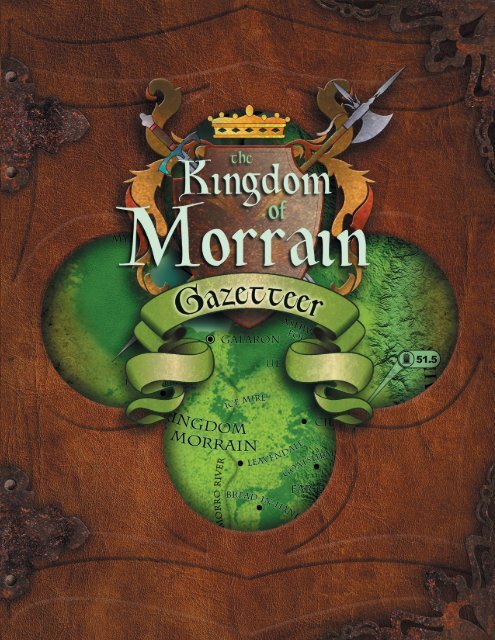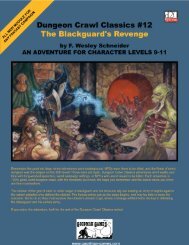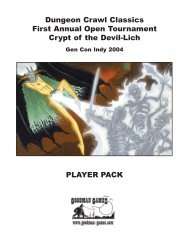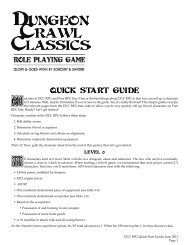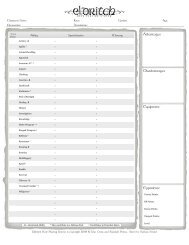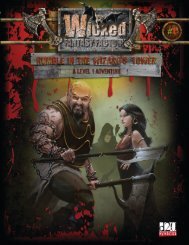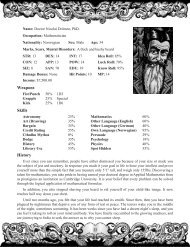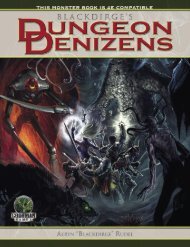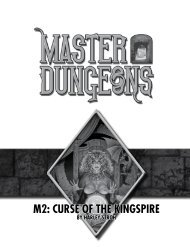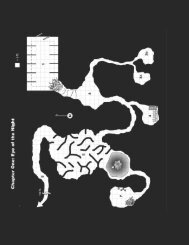Castle Whiterock Preview #3 - Goodman Games
Castle Whiterock Preview #3 - Goodman Games
Castle Whiterock Preview #3 - Goodman Games
Create successful ePaper yourself
Turn your PDF publications into a flip-book with our unique Google optimized e-Paper software.
Dungeon Crawl Classics:<br />
The Kingdom of Morrain<br />
Contents<br />
Chapter 1: Morrain Gazetteer Overview . . . . . . . . . . . . . . . . . . . . . . . . . . . . . . . . . . .2<br />
Chapter 2: Cillamar . . . . . . . . . . . . . . . . . . . . . . . . . . . . . . . . . . . . . . . . . . . . . . . . . . . . . .9<br />
Chapter 3: The Lay of the Land . . . . . . . . . . . . . . . . . . . . . . . . . . . . . . . . . . . . . . . . . .30<br />
Chapter 4: Culture . . . . . . . . . . . . . . . . . . . . . . . . . . . . . . . . . . . . . . . . . . . . . . . . . . . . . .35<br />
Chapter 5: Heroes, Villains, and Rulers of the Land . . . . . . . . . . . . . . . . . . . . .38<br />
Chapter 6: History . . . . . . . . . . . . . . . . . . . . . . . . . . . . . . . . . . . . . . . . . . . . . . . . . . . . . .45<br />
Chapter 7: Campaigns Set in Morrain . . . . . . . . . . . . . . . . . . . . . . . . . . . . . . . . . . . .53<br />
www.goodmangames.com<br />
1
Chapter 1<br />
Morrain Gazetteer Overview<br />
Long before Morrain was an independent kingdom,<br />
it was known to explorers as the Argent Vale—a<br />
wide and verdant basin surrounded by towering<br />
mountains in the east and thick, highland forests in the<br />
north and west. Rocky foothills, open tundra, and a mineral-rich<br />
river comprised the Vale.<br />
The passage of time and the influx of the civilized races<br />
have done little to change the vale’s wild geography.<br />
Since the time of Jorem the Elder and his famous son, the<br />
First Lord Morro Stormwarden, the people of Morrain<br />
have respected nature and taken from the land only what<br />
they need to survive. They cull lumber for their homes<br />
and hunt game for their food; they do not export these<br />
resources or seek to grow their economy with overt foreign<br />
trade. Only the silver mines and gem-rich hills provide<br />
material wealth that Morrain deigns to trade with<br />
neighboring kingdoms. Individual merchants may barter<br />
or sell for personal profit, but the rulers of Morrain have<br />
never sold its natural resources for greater wealth.<br />
The climate of Morrain showcases the extremes of<br />
Ildavir’s demesne. The entirety of the Vale has only two<br />
real seasons, summer and winter, with very short intervals<br />
of moderation between them. Summers are temperate,<br />
if wet, often beset by lightning storms. Strong winds<br />
howl through the Vale throughout the year and precipitation<br />
is frequent. Winters are long, cold, and heavy with<br />
snow. The dwarf-highways that wind about the mountainous<br />
eastern border are nearly inaccessible after the<br />
first snowfall, and the ponds, lakes, and waterways are<br />
often covered in a layer of ice. Even the most traveled<br />
roads are seldom traveled in the snow-filled months. A<br />
popular saying proclaims, “A man does not brave the<br />
Morrain midwinter unless he is a ranger, a fool, or a raiding<br />
giant.”<br />
The people of Morrain call themselves the Imorrayn—in<br />
an Elven dialect of the Common tongue, this means<br />
“sons of Morro”—though outside of the kingdom they<br />
are generally referred to as Morrahim or, less respectfully,<br />
Morrainians.<br />
Morrain is a monarchy bereft of the rigid feudalism common<br />
to the Northlands’ southern realms. Few of the people<br />
object to the mandates of their kings, for the Argent<br />
Sovereigns have always been light-handed. The current<br />
Sovereign is King Mirias Stormwarden, a ranger-king<br />
whose loyalty to his subjects is greater than the service he<br />
demands in return. Ruling from his throne in Stormkeep<br />
and defended by the Argent Knights, King Stormwarden<br />
is a man of martial renown and a friend to the natural<br />
world.<br />
Morrain exists at the behest of the Criestine crown, but<br />
none who have witnessed the courage of the Imorrayn<br />
doubt they are an independent people who owe allegiance<br />
to no one but their chosen sovereign. Spaced atop<br />
the highlands along the borders are squat towers that garrison<br />
the kingdom’s soldiers. The defenders of the realm<br />
compensate for their small numbers with sophisticated<br />
strategies, a system of watchfires atop every tower, and<br />
the conviction that they are the first line of defense<br />
against a brutal world. When their defenses are strained,<br />
the king looks to his own people to raise again the banner<br />
of freedom. The Imorrayn enjoy their days, for<br />
they’ve had to work and fight for their freedom.<br />
Yet when dragons, giants, and worse threaten the land,<br />
the people look to heroes without and within for aid.<br />
2
Settlements,<br />
Fortifications, and<br />
Ruins<br />
Morrain is considered by their southern neighbors<br />
to be a rural backwater. While the people<br />
aren’t as simple as most presume, the settlements<br />
do showcase a rustic way of life. The majority of<br />
Morrain’s major towns (and single city) are listed below,<br />
though by no means do they account for all of the kingdom’s<br />
settlements or its total population.<br />
As a rule, villages, hamlets, and thorps litter the Argent<br />
Vale, most of which are within a day’s travel (by foot) to<br />
one another. Most are agricultural in nature, the majority<br />
of its people farmers or gatherers. Blacksmiths and<br />
millers support the singular industries of these communities,<br />
repairing equipment or grinding the harvested grain.<br />
Though most of these smaller settlements do not have<br />
defensible walls, most do have a central refuge—such as<br />
a watchtower or temple—where residents can take shelter<br />
during the strongest storms or in the attack of marauders<br />
All towns include a market where people from the smaller<br />
outlying settlements can bring their produce to barter<br />
or sell for the goods available only in a larger community.<br />
More than one industry can be accounted for in a<br />
town, and the community as a whole will be more racially<br />
diverse. Most towns include at least one temple and<br />
one inn, while a handful of taverns serve as entertainment,<br />
gossip, and recreation for the people.<br />
By no means meant to be fully comprehensive, a sampling<br />
of inns, taverns, temples, and guilds is listed after<br />
each settlement’s description.<br />
(Small town, pop. 1,440)<br />
Bone Hollow<br />
Years before the founding of the Kingdom of<br />
Morrain, the ruins of <strong>Castle</strong> <strong>Whiterock</strong> were conquered<br />
by a powerful tribe of orcs known as the<br />
Broken Tusk. Decimated and then replenished again with<br />
the joining of other tribes, the orcs were ultimately<br />
betrayed by their drow allies. Stricken with a devastating<br />
disease, most were slain outright and a small fraction of<br />
the tribe managed to escape the drow into the wilds. Only<br />
a few dozen orcs had survived the disease, but they languished<br />
without the strength to defend themselves<br />
against the predators of the Vale.<br />
At last the survivors straggled into a tiny human village<br />
calling itself the Hollow. The orcs were given shelter and<br />
food, and their sickness purged by clerics of Elyr. The<br />
strongest orc (and thereby the leader), Gorsh<br />
Bonegrinder, was astonished at the compassion shown to<br />
them. Instead of venturing back to their northern homelands,<br />
the orcs decided to stay in the Hollow. When these<br />
same orcs later saved the town against a monstrous<br />
chimera, the village was renamed to Bone Hollow to<br />
commemorate the friendship between human and orc.<br />
Generations passed and occasional interracial marriages<br />
bred a very small population of half-orcs. Today, fully<br />
half of the town’s population is half-orcs, a friendly and<br />
3
hard-working collection of farmers, laborers, and herbalists.<br />
The town Elder is a half-orc named Eros Skullcrusher,<br />
who serves as both warrior and leader. His youngest<br />
daughter, Elidy, is the town’s chief favored defender, a<br />
warrior-cleric with a heart of gold and a sunny disposition.<br />
Inns: Pilgrim’s Rest (average).<br />
Taverns: Tankard & Tusk (average), the Wellspring<br />
(poor).<br />
Shrines & Temples: The Fount of Healing (temple of<br />
Elyr), the Waterspan (island-bridge and shrine of<br />
Thalass).<br />
(Small town, pop. 955)<br />
Bread-In-Hand<br />
Famous for its breads and cheeses, Bread-In-Hand<br />
is a community populated predominantly by<br />
tallfellow halflings who excel in the culinary arts.<br />
The town’s name is said to stem from a popular halfling<br />
proverb: “A slice of bread in hand is worth two loaves in<br />
the oven.” Though they trace their origins to the tribes of<br />
distant Gadjarria, the halflings of Morrain made Breadin-Hand<br />
(and its sister towns) their adopted home many<br />
generations ago.<br />
Any who bring trouble to Bread-In-Hand are sure to meet<br />
with the militia’s captain, Eagleton Southpaw, a young<br />
hero and veteran of the goblin incursions of recent years.<br />
The village Elder, an addled old halfling named<br />
Barnwick and grandfather to Eagleton, is more likely to<br />
tell stories than see to the day-to-day affairs of the community.<br />
Beloved as he is by the villagers, they don’t really<br />
mind.<br />
Inns: The Great Hearth (average).<br />
Taverns: Baker’s Dozen (average), Bull & Brandy<br />
(poor).<br />
Shrines & Temples: The Fountain of Plenty (temple of<br />
Denithae), the Pointing Stone (road sign and shrine of<br />
Olidyra).<br />
See Chapter 2.<br />
Cillamar<br />
(Small town, pop. 1,145)<br />
Far Cirque<br />
Far Cirque is a town of secrets and great wealth.<br />
Situated in a canyon of stone beneath a glacial<br />
crest of the Ul Dominor Mountains, the town is<br />
hidden from casual travelers. Only those who know<br />
where to look, or with the magic to pierce the misleading<br />
illusions which hide the town, can find it. Home to some<br />
of the Northlands’ finest gem-cutters and spelunkers, Far<br />
Cirque is a strange little community with a common<br />
vision: finding, perfecting, and selling gems. Not surprisingly,<br />
gnomes are plentiful here, accounting for nearly<br />
half the population.<br />
Far Cirque is an open secret, a source of great wealth for<br />
Morrain and many a rumor. Ringing the stony cliffs<br />
around the town is a vast network of gem mines, wellguarded<br />
and well-hidden. Far Cirque is an industrious<br />
mining town, not a place for indulging visitors. With so<br />
many gnomes present, however, there is much time for<br />
merriment and play. The dwarves who live here often<br />
grow frustrated at the work ethics of their gnomish comrades.<br />
When the gnomes work, they work with more<br />
focus and precision than any other; gems are pulled from<br />
the nearby mines, carried to the town, where they are<br />
weighed, cut, and polished. But when work stops, parties<br />
and pranks abound and no one—not even the dour,<br />
bearded folk—is exempt from their antics.<br />
Legend holds that the profusion of gems in surrounding<br />
rock stem from the Mava Terestere (“mother diamond” in<br />
the Gnome tongue), a massive gem of enormous power<br />
placed there by Poderon himself. The miners and<br />
lapidists of Far Cirque dream of finding the “Lost Mine”<br />
that houses the divine gem so that they can look upon its<br />
great beauty, but they are equally afraid that finding it<br />
means subjecting it to theft. The legend claims that if the<br />
Mava Terestere is removed from the mines, the mineralrich<br />
mines will go dry.<br />
The Elder of Far Cirque is Mistress Rorínna Berick, a<br />
gnomish sorceress who takes the legend of the Mava<br />
Terestere very seriously and believes herself personally<br />
responsible for the security of the town proper and the<br />
mines. She uses her illusionary magic to misdirect the<br />
road that leads into the town. In addition, she does not<br />
allow the population of Far Cirque to increase, for fear<br />
that greater numbers will call too much attention to the<br />
town and compromise its mining operations. She has the<br />
full support of King Stormwarden in her actions, and<br />
employs much of her own wealth to ensure that gem caravans<br />
bound for Galaron markets are heavily guarded.<br />
The folk of Far Cirque occasionally contend with goblins<br />
and kobolds who emerge from the mountainous depths,<br />
4
ut have always managed to drive<br />
them away. One captive from one<br />
such skirmish, a kobold trapsmith<br />
named Keez, has after many years of<br />
confinement finally achieved acceptance<br />
in the town. Now he serves as a<br />
security guard, setting ingenious<br />
stonework traps against intruders.<br />
Though most of the humans and<br />
gnomes trust him, the dwarf miners<br />
keep a careful eye on him.<br />
Inns: The Perfect Ruby (average).<br />
Taverns: Earthen Bounty (average).<br />
Shrines & Temples: The Delver’s<br />
Den (temple of Poderon), the Forger’s<br />
Fane (shrine to Daenthar),<br />
Guilds: Shapers (church-sponsored<br />
guild of gemcutters).<br />
Festivals: Day of the Diamond (commemorating<br />
the “discovery” of the<br />
Mava Terestere)<br />
Far Leurre<br />
(Empty “town”, pop. 2)<br />
Most who seek out the gemrich<br />
town of Far Cirque<br />
without a guide who knows<br />
the way are likely to find Far Leurre<br />
instead. The product of ingenious<br />
“geographic and architectural legerdemain,”<br />
this town is little more<br />
than a series of shoddy stone buildings<br />
and empty wells. Once a small<br />
village predating Morrain itself, it has<br />
since been transformed into a magical<br />
decoy of gnomish ingenuity.<br />
All but the most powerful divination<br />
spells employed to find Far Cirque<br />
are magically redirected to Far Leurre. In addition, those<br />
who arrive in Far Leurre will find a sleepy, dilapidated<br />
town whose residents are boorish and cranky. Even the<br />
shoddy sign that reads “Far Cirque” at the edge of town<br />
is in need of repair. In truth, the buildings and the townsfolk<br />
are nothing more than powerful illusions woven by<br />
two gnomish sorcerers, Pavelon and Ravelon, who live<br />
here at the behest of Mistress Rorínna Berick of Far<br />
Cirque. Eccentric and easily amused, the two brothers<br />
enjoy duping the fortune hunters, bandits, and adventurers<br />
who visit them. Even those who manage to penetrate<br />
the figments, glamers, and patterns of the gnomish brothers<br />
usually grow frustrated by the<br />
experience and give up their search<br />
for the real gem-rich town.<br />
Galaron<br />
(Small city, pop. 8,527)<br />
The only true city in the kingdom<br />
and the seat of its monarchy,<br />
Galaron is yet a small<br />
community compared to the great<br />
metropolises of the south. Still, no<br />
other city in the region is as defensible<br />
as Galaron, its orphic, green-hued<br />
walls rising high along the southern<br />
shore of Valfors Bay and the mouth<br />
of the Morro River.<br />
Galaron is the largest hub of commerce<br />
for hundreds of miles in any<br />
direction. The population is in constant<br />
flux, as merchants and traders<br />
from across the region travel to the<br />
markets of Galaron each year and<br />
many choose to stay, caught by the<br />
spirit of communal self-preservation<br />
that defines the kingdom. The<br />
Galarons are rural-minded, as four<br />
out of every five citizens has family<br />
somewhere in the Morrain countryside.<br />
Some visitors from foreign<br />
kingdoms regard the folk of Galaron<br />
as simpletons, but upon returning<br />
home find that their own people are<br />
callous and cynical by comparison.<br />
Adventurers have always been welcome<br />
in the city, as evidenced by the<br />
many prosperous taverns and inns<br />
who vie for their hard won gold.<br />
The wharves of the city teem with<br />
life, as fishermen compete with<br />
explorers for docking space. The cry<br />
of gulls and the scent of saltwater<br />
permeate the bayside district, as the longshoremen sing<br />
their shanties and foul the air with good-hearted profanity.<br />
Ship captains are numerous, most willing to ferry passengers<br />
across Valfors Bay for gold in advance during<br />
summer or early fall. As adventurers bring only sporadic<br />
business, the sailors owe their livelihood to the fishermen<br />
and hunters who ply the hinterlands and waters of the bay<br />
year round. Exotic animals and furs are often sold in the<br />
markets, and lush Morrain furs are considered a luxury<br />
by the southern nobility.<br />
Though the city owes its continued existence to the valor<br />
5
6<br />
of its people, none dismiss the magic rumored to infuse its<br />
very walls. Shortly after the demise of the First Lord five<br />
centuries ago, walls that appear to be an aggregate of<br />
granite and malachite arose seemingly overnight. In the<br />
taverns of the city, legends still tell of the mysterious<br />
cloaked men who attended the funeral of Morro<br />
Stormwarden and raised the walls for the city’s perpetual<br />
defense. The gleaming bulwark is wondrous to look upon<br />
during the day, but it is a sight to behold at night: a ghostly<br />
green glow emanates from the veins of malachite.<br />
History has seen many armies lay siege to Morrain’s capital<br />
city, but none have succeeded in breaching its walls,<br />
which cause magic and siege weaponry to rebound.<br />
Rising from the heart of the city is Stormkeep, the home<br />
of King Mirias Stormwarden, the Argent Sovereign. The<br />
fortress is as formidable as any dwarf citadel, though its<br />
garrison is small. Built of black-veined gray stone,<br />
Stormkeep consists of a series of high towers and crenellated<br />
walls, with a long drawbridge spanning a “moat” of<br />
deadly elemental wind. The citadel is also home to a regiment<br />
of paladins known as the Argent Knights, who<br />
serve as both royal guards and elite soldiers in times of<br />
need. The Knights are led by the elfmaid Lady Tyaline<br />
and are devoted to Gorhan, the Helmed Vengeance.<br />
Much like the faith of Gorhan, the Knights are racially<br />
diverse; fully half of the regiment consists of nonhumans.<br />
The criminal element of Galaron is trenchant but small,<br />
subsisting on citizens and visitors alike like a sufferable<br />
parasite, taking only what it requires while leaving its<br />
victims healthy. When true peril threatens the city, the<br />
rogues themselves take up arms against the common<br />
enemy. “Should Galaron fall,” one adage proclaims,<br />
“hope for all of Morrain is lost forever.” While some<br />
attribute the thieves’ uncanny symbiosis to the community—or<br />
simple pragmatism—others believe there is a single<br />
mastermind who rules the underworld. Folk tales persist<br />
that Vemn himself, the legendary thief and one of<br />
Morro Stormwarden’s own companions, lingers still in<br />
spectral form, enforcing his guiding principle of Thieves’<br />
Honor in death as he did in life.<br />
The flaw of complacency cannot be attributed to the people<br />
of Galaron. Life is short, and tomorrow the dragons<br />
of the Frosteye Mountains could fall upon them en masse<br />
or the Scourge in the east could breach the Ul Dominor<br />
Mountains and overtake them. Therefore they live life to<br />
its fullest, celebrating the rise of the sun each day and<br />
every successful hunt. This spirit of merriment has kindled<br />
even the hearts of its nonhuman residents. As the<br />
elves sing and dance to the music of the Anseur glades,<br />
the dwarves raise their tankards and host drinking games<br />
by their Holdfast kin. The gnomes and halflings, of<br />
course, need little excuse to join their taller neighbors.<br />
Despite the cold climate of Morrain, Galaron hosts festivals<br />
throughout the year. Between such events, individual<br />
families hold their own revels.<br />
Among the city’s most famous locales is the Garden of<br />
Tears, a labyrinth of hedges, trees, and cool arbors<br />
enclosed by low stone walls. Planted and cultivated by<br />
the church of Ireth, the Garden stands adjacent to the<br />
Starspire, temple of the goddess of the night sky. The<br />
“tears” that give the garden its name are the dewdrops<br />
that appear among the leaves at dawn and freeze in the<br />
wintry months. It is believed that those who walk among<br />
the arbors long enough can face their fears, grieve for<br />
their regrets, and leave their sorrows behind.<br />
Inns: The Emerald Wyrm (expensive), the Elven Oak Inn<br />
(expensive, elvish decor and cuisine), Warrior’s Rest<br />
(average), the Root Cellar (average, gnome-catered), the<br />
Road’s End (average, halfling-catered).<br />
Taverns: The Silver Chalice (expensive), the Falcon &<br />
Child (average), the Wyvern’s Head, the Landshark<br />
(average), Fish N’ Guts (poor, dockside).<br />
Shrines & Temples: Valiant Hall (temple of Gorhan),<br />
the House of Fire (temple of Fenwar), the Starspire<br />
(observatory and temple of Ireth), Vault of Radiance<br />
(temple and library of Delvyr), Halls of the Silent (mausoleum,<br />
cemetery, and temple of Soleth), the Bellhouse<br />
(lighthouse, anchorage, and shrine dedicated to Ilquot;<br />
located on a jetty).<br />
(Ruined town, pop. 50)<br />
Hallowbrook<br />
Once a proud and bustling town, and home to<br />
Morrain’s forefathers, the population of<br />
Hallowbrook has nearly vanished as many consider<br />
it a cursed place. Now only a despondent few live<br />
among the empty buildings and eke out a lonely existence<br />
among the silent walls and untended wells.<br />
At the center of the ruin are four black marble statues<br />
depicting Morrain’s founding men and women—Jorem,<br />
Dalrem, Eistha, and Tarom—frozen in their moments of<br />
anguished death. The statues are said to be the result of a<br />
horrible wish granted by a demon to the hated Harbinger<br />
King five hundred years ago. When the defiant Elders of<br />
the early towns refused to bow to his rule, the tyrant<br />
ordered them slain. It was the Elders’ own children—<br />
including Morro Stormwarden—who would later overthrow<br />
the Harbinger King, prompted by revenge.<br />
The Imorrayn have tried many times to tear down the<br />
statues, but powerful magic sustains them. Not even rare<br />
adamantine alloys can sunder them. Instead, the statues<br />
live on as a reluctant symbol of the sacrifices the people<br />
of the Vale made to win their freedom, and the pain one<br />
must suffer to see justice done.
Hrumbleton<br />
(Small town, pop. 1,112)<br />
Nestled in the foothills of eastern<br />
Morrain, Hrumbleton is a<br />
community of gnomes that<br />
has existed since before the Kingdom<br />
of Morrain. When the First Lord united<br />
the land, however, the friendly<br />
gnomes of Hrumbleton were happy to<br />
join in the commonwealth. Although<br />
the hill-dwelling burrows of<br />
Hrumbleton are built for shorter folk,<br />
humans, elves, and half-elves are just<br />
as welcome; the tall folk and a number<br />
of dwarves make up nearly ten<br />
percent of the population.<br />
The people of Hrumbleton take life a<br />
day at a time. They have little history<br />
beyond the memory of the eldest<br />
gnome and heirlooms passed down<br />
the generations. As one gnome patriarch<br />
said, “Unlike elves, we have no<br />
millennial heritage; unlike the<br />
dwarves, no death-knell tomorrow.”<br />
The town has always been governed<br />
by a single, elected clan. But long ago<br />
the gnomes become quite content<br />
with a particular family, Clan<br />
Wedgebender, and never sought to<br />
change. Its current patriarch, Glozark,<br />
has been the Elder of Hrumbleton for<br />
nearly three decades. Glozark is a<br />
shrewd businessman, but he knows<br />
more about trade and the mining<br />
operations of his people than he does<br />
about defense.<br />
Whenever the town is threatened, or<br />
when faced with a decision beyond<br />
his ken, he consults with the sorcerer<br />
Nerebon Stimblebor Sandminder, a<br />
kindly old gnome whose magic and leadership has saved<br />
the town many times from goblin raiders. The town is<br />
also home to one of Áereth’s most famous—and eccentric—gem<br />
cutters, the esteemed Master Geresain.<br />
Mystenmere<br />
(Small town, pop. 1,890)<br />
Mystenmere is Morrain’s window<br />
into the elven nation of<br />
Anseur. Built in the shadow<br />
of the elven wood and overlooking<br />
Valfors Bay on its western shores, it is<br />
the home of scholars, wizards, and<br />
hunters with a deep respect for the natural<br />
world. An embassy in all but<br />
name, the queen of Anseur has extended<br />
her protection over the town—a<br />
gesture greatly appreciated by the<br />
Argent Sovereign. In turn, the king<br />
sends ambassadors into the elven<br />
realm to keep the queen apprised of<br />
events well outside her forest.<br />
If Mystenmere had an Elder, it would<br />
be the haggard mage in brown robes<br />
who lives in an unobtrusive tower at<br />
the center of the town square.<br />
Aragoth is a venerable human of<br />
unknown years, and certainly<br />
Mystenmere’s oldest human resident.<br />
He emerges from his tower only during<br />
the most monumental of occasions<br />
or when a governmental decision<br />
is needed. Considered a preeminent<br />
sage of the Northlands, Aragoth<br />
always knows more than he tells.<br />
Those seeking counsel with the old<br />
wizard are faced with two choices:<br />
wait a very, very long time (often<br />
spanning weeks or months) or perform<br />
a service for him. Services have<br />
included journeys to the Dyzan sea<br />
caves, retrieval of rare spell components<br />
in the Ashwood Forest, and<br />
deliverance of puppies to children in<br />
the town of Bone Hollow. Visitors<br />
must be prepared for anything.<br />
Mystenmere is also the home of a semi-renowned society<br />
of arcanists—mostly consisting of wizards, sorcerers,<br />
and loremasters—named the Tome, which meets monthly<br />
in a back room of the Twisted Staff. The wait staff of<br />
the esteemed inn has reported dry laughter, archaic languages,<br />
and lecturing old voices. Even the Staff’s proprietor<br />
feels certain he can hear more men speaking behind<br />
the closed door than arrive at his inn.<br />
Inns: The Twisted Staff (expensive), the Raven’s Nest<br />
(average).<br />
7
Taverns: The Dark Archer (average), Gozarr’s Flagon<br />
(dwarf-run, average), the Sylvan Wolf (average).<br />
Shrines & Temples: The House of the Starmistress<br />
(temple of Ireth), the Elder Stone (menhir and shrine to<br />
Ildavir), Hallowed Well (water well and shrine to<br />
Thalass).<br />
(Small town, pop. 1,886)<br />
Omarak<br />
Often serving as a stopping point for those entering<br />
Morrain from the west, Omarak is a mysterious<br />
town whose residents hold an inexplicable reverence<br />
for their ruler. The stone houses and pavilions seem<br />
architecturally advanced for their location, and often mislead<br />
newcomers into thinking the rest of Morrain must be<br />
similarly advanced. The townsfolk are courteous and<br />
friendly, but seldom exhibit a desire to leave their curious<br />
home.<br />
With close proximity to the feared Witch Wood, residents<br />
and travelers alike tend not to stray far off the road unless<br />
it is to visit one of the outlying farms. Inexplicable oddities<br />
litter this region, such as the infamous Devil’s Well<br />
and the spectral horses which are said to trot upon the<br />
road on moonless nights.<br />
Dominating the center of the town is a gray marble structure<br />
that serves as both town hall and abode for Omarak’s<br />
mysterious ruler. Aszen Juthow is an enigmatic man of<br />
mental powers who hails from a faraway land. According<br />
to legend, Aszen slew a powerful demon of the Abyss<br />
when he first came to Omarak, but for his struggle he fell<br />
into a thirty-year slumber. When he awoke, he deigned to<br />
stay as the town’s Elder and look after the people for fear<br />
of the coming of another terror. Foreign adventurers are<br />
frequently seen visiting Aszen, and often times outlandish<br />
music can be heard echoing from within his<br />
chambers, but the soft-spoken demeanor of this eccentric<br />
man never changes.<br />
8


